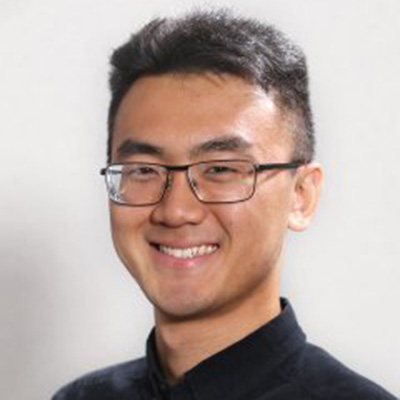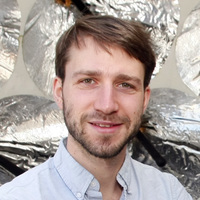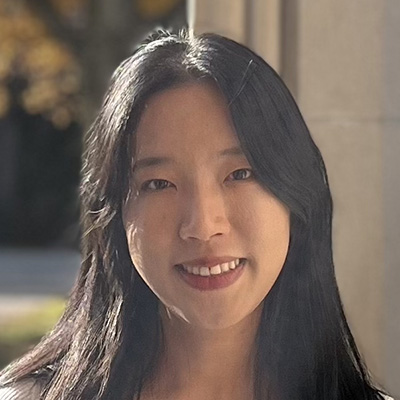2023 E-ffiliates Retreat
posters and abstracts
-
 Xunkai Chen1
Xunkai Chen12nd Year Ph.D. candidate
Principal Investigator: Kelsey Hatzell2,31 Department of Chemical and Biomolecular Engineering
2 Andlinger Center for Energy and the Environment
3 Department of Mechanical and Aerospace EngineeringChemomechanical Evolution of Silicon Anodes during Electrolyte Freeze-Thaw Cycles
Abstract
To support longer space missions, batteries need to endure a wide range of extreme temperatures (-150°C – 300°C). During this temperature swing, the electrolyte might freeze which could possibly cause damage to the electrode performance after thawing. In this poster, we proposed a way to cryo-freeze cells and measure the electrochemical performance after thawing to investigate the chemomechanical changes incurred due to the freeze-thaw cycle. SiO electrodes with various compositions and structures are designed to compare the influences of the freeze-thaw cycles. Future materials characterizations are proposed to evaluate possible mechanical or crystal structure changes.Bio
Chen earned his bachelor’s degree in chemical and biomolecular engineering from the University of California, Berkeley. He has a diverse research background in theoretical modeling, 2D materials, polymer/polyelectrolyte chemistry, and electrochemical and materials characterizations. Chen is interested in studying next-generation anodes (such as silicon) failure mechanisms in traditional LIB and novel ASSB cells using electrochemical and x-ray imaging techniques. He hopes that by developing a comprehensive understanding of silicon electrode failure behaviors, he can use his knowledge to contribute to the commercialization of high energy density, high cycle life batteries for energy storage applications. -
 James Coleman1
James Coleman1 2nd Year Ph.D. candidate
Principal Investigator: Forrest Meggers1,21 School of Architecture
2 Andlinger Center for Energy and the EnvironmentSmart Building Infrastructure as a Scaffold for Faculty and Student-led Research
Abstract
A modern Building Management System (BMS) provides most of the network and data management infrastructure necessary for ongoing energy, health, and comfort research in buildings. Many of the sensors and actuators required for basic automation provide can also provide valuable data for research by faculty and students alike. Collaborating with the Offices of Sustainability and Capital Projects, we are identifying opportunities for research presented by baseline “smart building” infrastructure and providing a critical gap analysis of those additional features which may streamline research over the life of a building, such as metadata standards and support for IoT protocols.Bio
Coleman’s research focuses on modernizing the tech stacks used in building systems by applying tools and techniques from modern computer science, primarily from the areas of distributed systems, machine learning, and information security. Prior to starting his Ph.D. in the Architecture, Energy and Computation track with Princeton’s CHAOS Lab, he was a consulting engineer at a top NYC firm where he helped large real estate owners modernize their operation and management practices. Coleman has also been a product manager in the construction technology, Internet of Things, and building performance benchmarking spaces. A core goal of his research is increasing access to energy-saving building automation technology. -
 Erfan Hosseini1
Erfan Hosseini11st Year Ph.D. candidate
Principal Investigator: Elie Bou-Zeid11 Department of Civil and Environmental Engineering
Energy + Food: The Benefits of Combining Photovoltaics with Crop Cultivation
Abstract
This project aims to quantify the benefits of agrivoltaics for improved design. With a growing population and increasing energy and food demand, competition for land resources is intensifying. The need to generate 6000 TWh of PV power to mitigate climate change exacerbates this challenge. Agrivoltaics, which integrate photovoltaics with crop cultivation, offer a potential solution. By harnessing the synergy between clean energy generation and crop productivity, agrivoltaics can optimize land use. This research seeks to uncover the advantages of agrivoltaics through comprehensive analysis, guiding the development of sustainable and efficient integrated systems for a greener future.Bio
Hosseini graduated with a bachelor’s degree from Sharif University of Technology and works in the Department of Civil and Environmental Engineering under the guidance of Elie Bou-Zeid. His current research focuses on solar energy, aiming to address critical challenges in solar farms. Hosseini’s work promises to contribute valuable insights and advancements to climate change mitigation and optimal configuration of solar farms, especially agrivoltaics farms. -
 Coleman Merchant1
Coleman Merchant1Research Associate
Principal Investigator: Forrest Meggers1,21 Andlinger Center for Energy and the Environment
2 School of ArchitectureMapping the Missing Half of Thermal Comfort: Radiant Heat and Sensing
Abstract
Conditioning buildings is a major source of energy use and emissions. Traditionally, efficiency gains are achieved through developing HVAC equipment that require less energy, or less carbon-intensive forms of energy, to produce a given amount of heat transfer. However, there is an alternative and complementary optimization: reduce the necessary transfer of heat required to keep people comfortable, for better exergetic and ‘humancentric’ comfort efficiency. Radiant heat transfer has great potential for this, but is often mischaracterized, misunderstood and underutilized; therefore, we develop novel sensors and analysis methods to break down the barriers to developing and utilizing such radiant systems.Bio
Merchant’s research focuses on achieving a better understanding of the invisible world of radiant heat transfer in the built environment through novel sensing methods, with the goal of engendering heating and cooling systems that more directly and efficiently keep people comfortable. Prior to joining Princeton’s CHAOS Lab, he completed his undergraduate degree at Princeton in mechanical and aerospace engineering, briefly worked in the aerospace field and went through the HAX hardware accelerator program with a startup spun out from the CHAOS Lab. -
 Eric Teitelbaum1,2
Eric Teitelbaum1,2Postdoctoral Research Associate
Principal Investigator: Forrest Meggers1,31 Andlinger Center for Energy and the Environment
2 AIL Research, Inc. Hopewell, NJ
3 School of ArchitectureMethod and Demonstration of Direct Expansion (DX) Radiant Cooling for New Efficient Heat Pump Opportunities
Abstract
Heat pumps play a critical role in the future of thermal comfort and a decarbonized building infrastructure. The analysis of pumping heat from a source (air, ground, water, etc.) to a sink (air or water) often focuses on either sinking heat in air, sometimes with a secondary working fluid such as water, if devices such as radiant panels are used. Each additional component adds inefficiency. We have constructed a direct expansion radiant cooling panel that provides cooling directly to occupants from the heat pump, without transmission losses.Bio
Teitelbaum is a senior engineer at AIL Research in Hopewell, NJ, as well as an adjunct assistant professor at Cooper Union and a lecturer at the University of Pennsylvania. He completed a dual degree Ph.D. in 2020 from Princeton University in architecture and material science, researching how materials enable energy-saving thermal comfort regimes. His work on novel cooling solutions has appeared in the Washington Post, Proceedings of the National Academy of Science, and Scientific American. -
 Prerit Terway1
Prerit Terway15th Year Ph.D. student
Principal Investigator: Niraj K. Jha1
with Stevens Institute of Technology, Peraton Labs1 Department of Electrical and Computer Engineering
REPAIRS: Gaussian Mixture Model-Based Completion and Optimization of Partially-specified Systems
Abstract
REPAIRS is an artificial intelligence (AI) framework that addresses real-world system design and optimization challenges. Using Gaussian Mixture Models (GMM), REPAIRS learns the relationships between system inputs and corresponding output responses. This allows for optimizing partially-specified systems, filling in missing information, and enhancing data integrity. The framework can identify multiple response modes associated with different combinations of input values, providing a comprehensive understanding of system behavior. Importantly, REPAIRS incorporates a robust data integrity verification mechanism to identify and correct errors in the given data, thus avoiding potential catastrophic consequences from incorrect data. This tool also enhances transparency by explaining all its decisions.Bio
Terway is a fifth-year Ph.D. candidate in electrical and computer engineering at Princeton University. His research is on black box-constrained multi-objective optimization problems, uncertainty quantification and error detection, location, and correction. He developed a tool that models multi-modal behavior (same response for different input choices) that captures uncertainty in the system behavior and explains the decision. He has applied his work to various applications like electrical circuits, unmanned underground vehicles, unmanned air vehicles, and power electronics. -
 Yanjie Zheng1
Yanjie Zheng13rd Year Ph.D. candidate
Principal Investigator: Kelsey B. Hatzell1,21 Department of Mechanical and Aerospace Engineering
2 Andlinger Center for Energy and EnvironmentUltra-sparse View 3D Reconstruction in X-ray Computed Tomography
Abstract
X-ray Computed Tomography (CT) is a non-invasive, non-destructive approach to imaging material and material systems in three dimensions. We introduce a 3D sparse view reconstruction deep learning model capable of reconstructing high-fidelity 3D microstructures. Our reconstruction model aligns pixel and voxel in the 3D coordinate system via the physics of X-ray imaging – Beer-Lambert law so that it can learn to predict the phase of each spatial voxel with the grayscale value from 2D radiographic images. Experimental 2D and 3D X-ray images were used as reference samples to test the reconstruction capability. The model can restore the 3D microstructures in the structural similarity (SSIM) of >0.997 from <10 radiographic images. Our study is among the first attempts to study the X-ray tomography 3D reconstruction for material microstructure from single-digit radiographic images with deep learning methods.Bio
Zheng earned a bachelor’s degree in thermal energy and power engineering from the Beijing Institute of Technology and a master’s degree in automotive engineering from Clemson University. Her research interests include in situ X-ray characterization for micron-scale ceramic proppants, design and optimization for micro-scale thermal energy storage, heat exchanger and solar thermal desalination, and techno-economic analysis for macro-scale decarbonized industrial process heat. Zheng has published in Joule, Desalination and Applied Thermal Engineering, and holds two patents for renewable thermal desalination devices.
